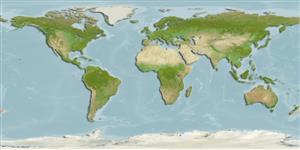ຊັ້ນຂອງກຸ່ມປາທີ່ມີຄີຫູໃຫຍ່ຄ້າຍປີກໃນທະເລ (ratfish) (chimaeras) >
Chimaeriformes (Chimaeras) >
Chimaeridae (Shortnose chimaeras or ratfishes)
Etymology: Chimaera: Named for the mythological creature composed of parts of multiple animals, referring to their odd mix of characteristics. (See ETYFish); carophila: Named for Carol and Phil Kemper (caro + phil), supporters of chimaeroid research (and the senior author’s parents). (See ETYFish).
Environment: milieu / climate zone / depth range / distribution range
ນິເວດວິທະຍາ
ສັດທະເລ ກ່ຽວກັບ(ຢູ່)ຊັ້ນນ້ຳໃນທະເລທີ່ເໜີອພື້ນດິນ; ລະດັບຄວາມເລິກ 846 - 1350 m (Ref. 107024), usually ? - 1000 m (Ref. 107024). Deep-water; 32°S - 49°S, 166°E - 171°W (Ref. 107024)
Southwest Pacific: deep water slopes and plateaus surrounding New Zealand (Challenger Plateau, Chatham Slope and Rise, Hikurangi Trench, Campbell Plateau,
Bounty Plateau).
ຂະໜາດ / ນ້ຳໜັກ / Age
Maturity: Lm ? range ? - ? cm
Max length : 104 cm TL ຕົວຜູ້/ບໍ່ມີເພດ; (Ref. 107024); 97.5 cm TL (female); ນ້ຳໜັກສູງສຸດທີ່ເຄຍຈັດພີມມາ: 4.8 kg (Ref. 122636)
Short description
ຕົວທີ່ໃຊ້ໃນການຈຳແນກຊະນິດ | ສະລີລະວິທະຍາ | ການວັດແທກຮູບຮ່າງລັກສະນະພາຍນອກຂອງດິນ,ສັດ,ປາ…
This species is distinguished by the following characters: a short, blunt snout and an anal fin separate from the ventral caudal margin by a notch; medium-bodied with a gently rounded snout; large eye; oral and preopercular lateral line canals usually share a short common branch off of the infraorbital canal; relatively short first dorsal fin and spine; second dorsal fin even along height, long caudal dorsal and ventral margins, short, trifurcate pelvic claspers, divided distally for approximately one-third of their length; body colour uniform pale-brown, mouth and ventral snout darker with brownish-purple fins and highly deciduous skin. Distinguished from its closest congeners, Chimaera fulva, C. macrospina, and C. obscura, by a combination of morphological characters (longer caudal dorsal margin, shorter pelvic claspers, shorter dorsal fin spine, shorter first dorsal fin, and longer caudal ventral margin) and coloration (Ref. 107024).
The depth range of occurrence of this species seems to follow the 1000 m depth contour around New Zealand, but may be an artifact of sampling. Size range for juvenile females 27.7-75.9 cm TL (18.2-37.6 body length) and males 41.0-83.5 cm TL (16.7-52.2 cm BDL); for adult females 85.5-103.5 cm TL (51.9-59.9 cm BDL) and males 74.0-97.5 cm TL (48.7-57.0 cm BDL) (Ref. 107024).
Life cycle and mating behavior
Maturities | ການສືບພັນ | Spawnings | Egg(s) | Fecundities | ຕົວອ່ອນ
Kemper, J.M., D.A. Ebert, G.J.P. Naylor and D.A. Didier, 2015. Chimaera carophila (Chondrichthyes: Chimaeriformes: Chimaeridae), a new species of chimaera from New Zealand. Bull Mar Sci. 91(1):63-81. (Ref. 107024)
IUCN Red List Status (Ref. 130435)
Threat to humans
Harmless
Human uses
ເຄື່ອງມື
Special reports
Download XML
ແຫຼ່ງອີນເຕີເນັດ
Estimates based on models
Phylogenetic diversity index (Ref.
82804): PD
50 = 0.5000 [Uniqueness, from 0.5 = low to 2.0 = high].
Bayesian length-weight: a=0.01000 (0.00244 - 0.04107), b=3.04 (2.81 - 3.27), in cm total length, based on all LWR estimates for this body shape (Ref.
93245).
ຊັ້ນເຂດຮ້ອນ (Ref.
69278): 3.7 ±0.6 se; based on size and trophs of closest relatives
ຄວາມຢືດຢຸ່ນ (Ref.
120179): ຕຳ່ຫຼາຍ, ປະຊາກອນຕຳ່ສຸດທີ່ໃຊ້ເວລາສອງເທົ່າຫຼາຍກວ່າ 14 ປີ (Preliminary K or Fecundity.).
Fishing Vulnerability (Ref.
59153): High vulnerability (62 of 100).
